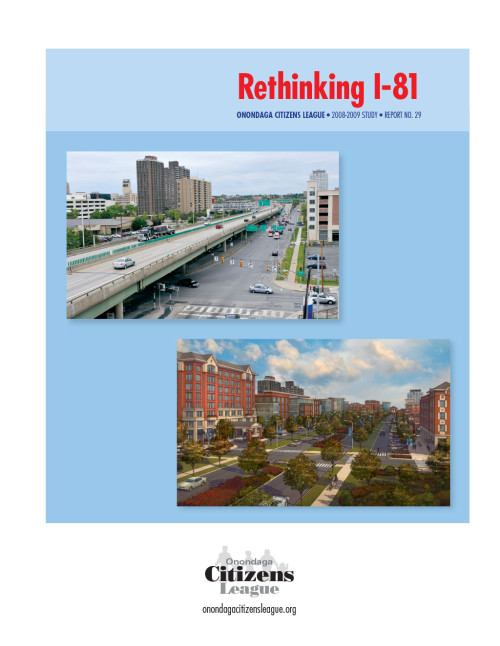Web Sites
Roundaboutswww.nysdot.gov/portal/page/portal/main/roundabouts
Milwaukee’s Freeway Plan and Freeway Revolt
http://www.preservenet.com/freeways/
FreewaysParkEast.html
15 Seconds that Changed San Francisco
http://www.sfgate.com/cgi-bin/article.cgi?f=/c/
a/2004/10/17/MNCITY1.DTL
Lessons from San Francisco
http://www.streetfilms.org/archives/lessons-
from-san-francisco
Planetizen – Removing Urban Freeways
http://www.planetizen.com/node/23300
University Hill Study
http://universityhillstudy.com
Sean Kirst’s Blog
http://blog.syracuse.com/kirst/downtown_syracuse
Oklahoma City Core to Shore Plan
http://www.okc.gov/Planning/coretoshore/index.html
Marquette Interchange Project, Milwaukee, WI
http://www.mchange.org/index.jsp
Congress for the New Urbanism Highways to Boulevards Initiative
http://www.cnu.org/highways
Articles
The Next Slum?
by Christopher B. Leinberger
http://www.theatlantic.com/doc/200803/subprime
Some experts expect conventional suburbs to continue to sprawl ever outward. Yet today, American metropolitan residential patterns and cultural preferences are mirror opposites of those in the 1940s. Most Americans now live in single-family suburban houses that are segregated from work, shopping, and entertainment; but it is urban life, almost exclusively, that is culturally associated with excitement, freedom, and diverse daily life. And as in the 1940s, the real-estate market has begun to react.
Suburbs a Mile Too Far for Some
by Jonathan Karp
http://online.wsj.com/public/article_print/SB 121366811790479767.html
Nationally, the mortgage crisis and gasoline prices are accelerating the demand for close-in living among millennials (20-somethings) and baby boomers. In this Wall Street Journal article, Christopher Leinberger, a visiting fellow at the Brookings Institution, describes the structural shift as the “beginning of the end of sprawl.”
Urban Renewal, the 15th Ward, the Empire Stateway and the City of Syracuse, New York
by Aaron C. Knight, May 2007
http://acknight.com/15thWardThesis.pdf
Urban renewal programs of the 1950s through 1970s, coupled with the connection of older cities to the federal Interstate Highway system during the same time, dramatically changed the look of those cities. Syracuse, New York, is a perfect example city from which we can examine the impact – good and bad – of these developments and the effects they had.
City Curbs on Cars: Now Accelerating
by Neal Peirce
http://citiwire.net/post/144
For close to a century, the automobile has so boldly seized Americans’ imagination — sparking the economy, paving the continent, designing our neighborhoods — that even the thought of curbing its dominion seems unnatural.
But check what’s happening right now…. [more]
Shifting Urban Priorities?
Removal of Inner City Freeways in the United States
by Francesca Napolitano and P. Christopher Zegras
http://web.edu/czegras/www/Napolitan_Zegras_
FreewayRemoval_Final.pdf
This analysis suggests that freeway removal will take place only when (a) the freeway’s condition raises concerns about its integrity and safety; (b) a window of opportunity exists, some event that enables a freeway removal alternative to gain serious consideration; (c) the value of mobility is lower than other objectives such as economic development; and (d) those in power value other benefits more than they value the benefits associated with freeway infrastructure.
A working paper version of the published journal article can be found at:
REPORTS
The Current Problems of Interstate 81 through Downtown of Syracuse and Their Effective Solutions
by Baik, Galster, Jeong, and Seokgi
Maxwell Graduate Student Project, 12/11/07
The students define options for I-81 then assess the alternatives based on various criteria.
Stent (or Dagger?) in the Heart of Town: Urban Freeways in Syracuse, 1944–1967
Joseph F. C. DiMento, University of Californiahttp://jph.sagepub.com/cgi/reprint/8/2/133
This case study assesses the decision-making process for I-81 and I-690, and the importance of “the convergence … of the city planning goals of ‘slum clearance’ and redevelopment (later, urban renewal), on the one hand, and the transportation goals of eliminating congestion and improving vehicle mobility, on the other. Also important was the availability of nonlocal funding to a fiscally conservative city administration, one that was also deferential, often legally obligated to be, to state highway planning directions.”
Back to "Rethinking I-81"

